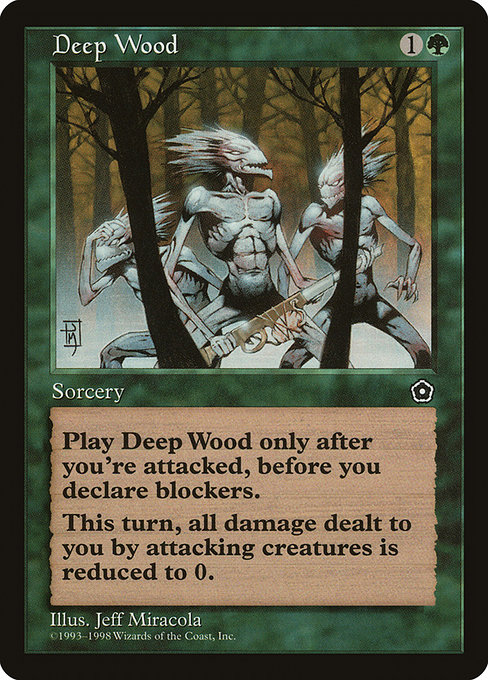
Image courtesy of Scryfall.com
Shifting tempo in the mid-game: a forest-grown surprise
In Magic: The Gathering, the mid-game is where tempo battles are won and lost—the moment when players trade explodes of power for careful, calculated survival. Deep Wood enters the arena as a modest 2-mana instant with a deceptively clean line of play: you cast it during the declare attackers step, and if you’ve been attacked this step, you prevent all damage that would be dealt to you this turn by attacking creatures. That little line of text wields a big swing 🧭. It doesn’t end the combat, but it surely changes how both sides approach the rest of the turn. Instead of fretting over life totals, you’re allowed to breathe, re-position your threats, and reshape your next attack or defense with a bit more confidence. It’s a tempo lifeline for green in a format that often rewards big bodies and bigger swings 🔥.
How the card shifts the turn, not just the life total
Deep Wood’s window is tightly gated: you must be attacked in the declare attackers step to cast it, and the effect lasts only for that turn. That constraint is a design feature as much as a rule quirk. You’re not negating damage from all sources—just the damage from attacking creatures. This makes it a precise tool for tempo management: you can absorb the alpha strike, buy a turn to stabilize, and then pivot into your next plan as your opponent’s creatures tire or your deck finds a way to press advantage 🧙♂️. The net effect is a subtle, patient win: you swing momentum from an onslaught to a controlled, methodical tempo swing that sets up a follow-up attack or a sweep of blockers on the opponent’s end step ⚔️.
Technically aligned with green’s bread-and-butter resilience, Deep Wood embodies the era’s love for clever timing and opportunistic defense. Its casting cost of {1}{G} is comfortably cheap, placing it squarely in early-to-mid-game decision windows. The card’s rarity—uncommon in Portal Second Age—pairs well with its practical value: a dependable, repeatable answer that doesn’t demand a steep mana curve or a heavy deck-building commitment. For players digging through 1998 nostalgia, it’s a crisp reminder of how early design constrained complexity into elegant, situational plays 🎨.
Deck-building ideas and practical use
- Tempo-control shells: In decks that lean on attacking pressure from green creatures, a well-timed Deep Wood can turn a bad beat into a tempo-positive exchange. You’d rather weather one grueling combat and push into the mid-game where your threats scale up. 🧙♂️
- Stall-and-transition concepts: Use Deep Wood as a bridge when you’re drawing into lands, animation, or a bigger ramp payoff. The moment you erase incoming damage from a swarm, you gain the space to deploy blockers, set up a defensive line, or push a two-step plan you’ve been storing in your hand 📜.
- Low-curve green picks: In a set like Portal Second Age, where you’re often working with lean mana bases, a reliable instant can be a surprising late-round answer that doesn’t steamroll your mana curve. It shines when you need to interrupt a decisive attack and flip the board state in your favor ⚡.
- Commander and Legacy-friendly vibes: While this card originated in a 1998 starter environment, its green resilience can translate into modern commander or legacy-esque mind games—particularly in formats that reward careful combat math and tempo manipulation. If your table enjoys a little retro-tech, this is a tasty nostalgia bite 🧩.
“Sometimes the best move isn’t the biggest creature you can cast, but the quiet moment when you deny the lethal damage and reset the rhythm.” — a well-worn whisper from the green-side of the table ⚔️
Thematic resonance isn’t the only thing Deep Wood brings to the table. Artist Jeff Miracola’s work for Portal Second Age captures that evergreen, mossy vibe—where the woods aren’t just scenery; they’re a strategic partner. It’s a reminder that nature isn’t passive in MTG’s world; it’s a living mechanic that protects, constrains, and occasionally accelerates the tempo of a match 🔎💎.
Value, reprints, and format reality
As a card from Portal Second Age (p02), Deep Wood sits in the vintage-legal, legacy-friendly corner of the history map. Its low mana cost, combined with the unique timing clause, makes it a small but meaningful part of a larger green toolbox. The print run is long behind us, and its current market price sits in the modest range, which is exactly the kind of accessibility that makes retro strategies inviting for newer players exploring tempo concepts 📈. For collectors who love the feel of late-90s MTG design, this card is a crisp specimen of that era’s approach to color and timing.
If you’re curious about staying organized on the go, check this practical accessory that’s been catching eyes in travel-friendly setups: the MagSafe Card Holder Phone Case Polycarbonate. It’s a concrete tip for players who want to keep their deck, dice, and device together—whether you’re drafting at a friend’s place or heading to Friday night magic. You can grab it here and see how stylish, compact storage can support those mid-game tempo swings in real life as well as on the tabletop 🔗🧳.
Product spotlight: Magsafe Card Holder Phone Case Polycarbonate
Magsafe Card Holder Phone Case PolycarbonateMore from our network
- https://blog.digital-vault.xyz/blog/post/mastering-responsive-design-for-modern-products/
- https://crypto-acolytes.xyz/blog/post/mitigating-impermanent-loss-risks-on-solana-defi-platforms/
- https://transparent-paper.shop/blog/post/typography-overlays-for-social-media-design-tips-that-pop/
- https://transparent-paper.shop/blog/post/hot-blue-star-illuminates-galactic-kinematics-via-dr3-precision/
- https://blog.digital-vault.xyz/blog/post/playtest-feedback-shapes-mirran-safehouse-design/